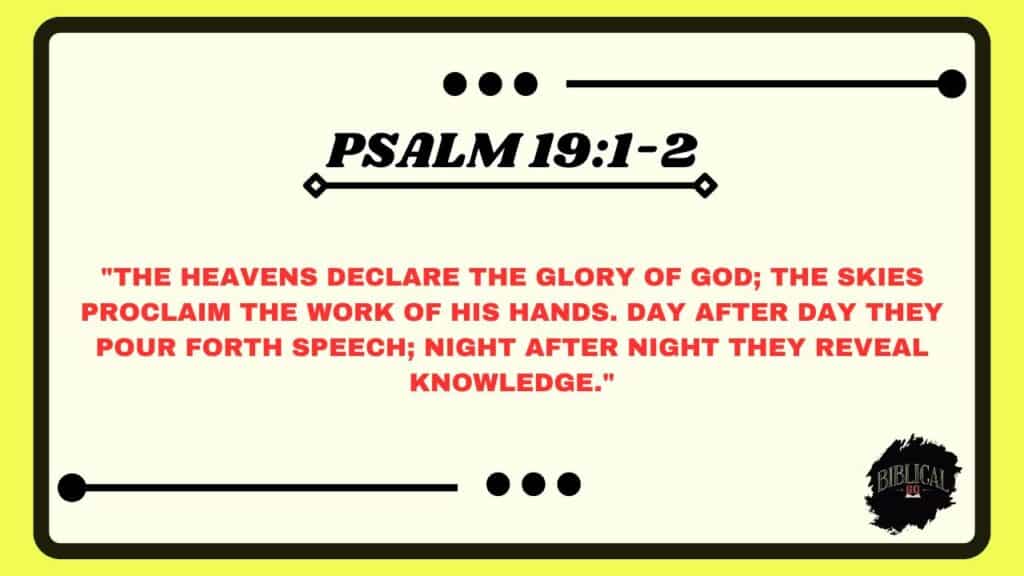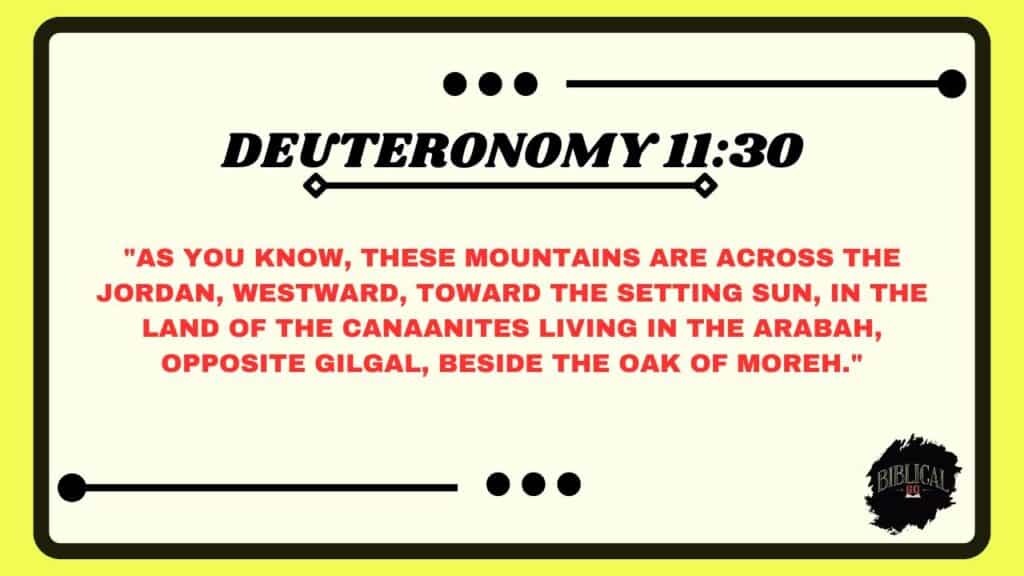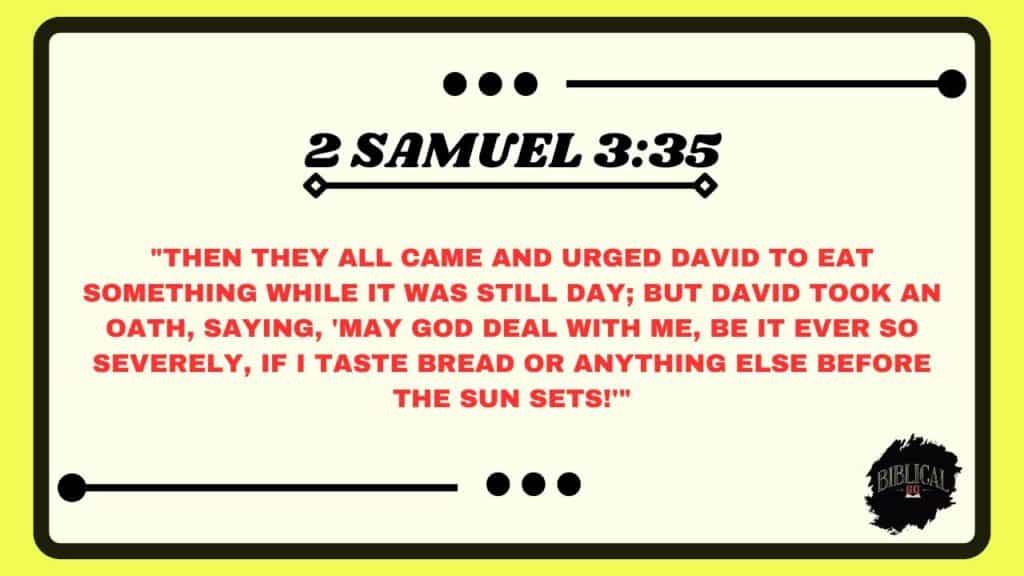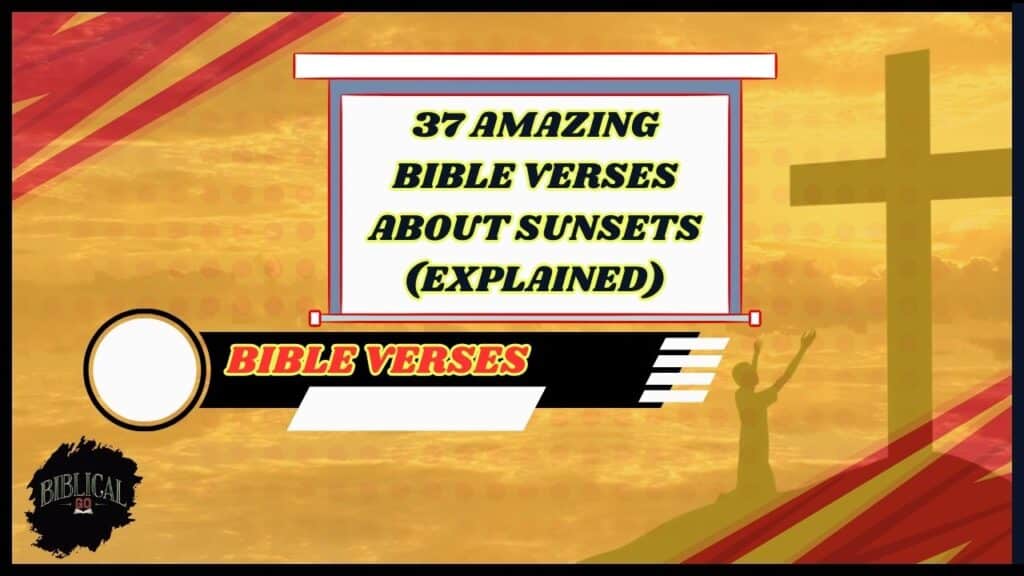Bible Verses About Sunsets: There’s something profoundly spiritual about watching the sun sink below the horizon, painting the sky with brilliant hues of orange, pink, and purple.
Throughout Scripture, sunsets serve as powerful metaphors for God’s faithfulness, the passing of time, and the promise of renewal. These moments when day transitions to night remind us of God’s artistry and the ordered rhythm He established in creation.
In the Bible, sunsets mark not only the end of a day but often symbolize deeper spiritual truths about endings, transitions, and God’s constant presence even as darkness falls.
From the ancient Israelites who marked the beginning of their days at sunset to Jesus teaching His disciples as the sun went down, these moments capture God’s glory displayed in creation.
Whether you’re seeking comfort, inspiration, or simply a deeper appreciation for God’s handiwork in nature, these 37 verses about sunsets will illuminate the spiritual significance behind one of creation’s most beautiful daily miracles.
Sunsets as Displays of God’s Glory and Creation
1. Psalm 19:1-2
“The heavens declare the glory of God; the skies proclaim the work of his hands. Day after day they pour forth speech; night after night they reveal knowledge.”

The psalmist reminds us that the sky including the breathtaking colors of sunset constantly testifies to God’s glory and craftsmanship. Every sunset is a divine communication, a heavenly language that speaks of God’s character and wisdom without using words.
2. Psalm 65:8
“The whole earth is filled with awe at your wonders; where morning dawns, where evening fades, you call forth songs of joy.”
This verse beautifully expresses how both sunrise and sunset the bookends of our day are meant to evoke worship. The changing colors of sunset should stir our hearts to praise God for His creative power that remains consistent day after day.
3. Genesis 1:5
“God called the light ‘day,’ and the darkness he called ‘night.’ And there was evening, and there was morning the first day.”
From the very beginning, God established sunset as the transition between day and night. This verse reminds us that the cycle of sunset and sunrise has been part of God’s perfect design since creation itself, a testimony to His orderly nature.
4. Psalm 104:19-20
“He made the moon to mark the seasons, and the sun knows when to go down. You bring darkness, it becomes night, and all the beasts of the forest prowl.”
Here, the psalmist acknowledges God’s sovereignty over the sun’s movements. Each sunset is a divine appointment, perfectly timed by the Creator who orchestrates all of nature’s rhythms with precision and purpose.
5. Psalm 113:3
“From the rising of the sun to the place where it sets, the name of the Lord is to be praised.”
This verse reminds us that God is worthy of praise throughout the entire day from sunrise to sunset. The daily journey of the sun across the sky should inspire continuous worship, with sunset being a natural moment to reflect on God’s faithfulness throughout the day.
6. Ecclesiastes 1:5
“The sun rises and the sun sets, and hurries back to where it rises.”
Solomon observes the consistent pattern of sunrise and sunset as an example of the cyclical nature of life. This verse invites us to find comfort in the reliability of God’s created order, even as our lives undergo change and transition.
7. Joshua 10:13
“So the sun stood still, and the moon stopped, till the nation avenged itself on its enemies, as it is written in the Book of Jashar. The sun stopped in the middle of the sky and delayed going down about a full day.”
This extraordinary account of God delaying sunset for Joshua’s battle reminds us that while God established the sunset as part of natural order, He remains sovereign over it. The delayed sunset demonstrated God’s power to intervene in natural processes when His purposes require it.
8. Habakkuk 3:11
“Sun and moon stood still in the heavens at the glint of your flying arrows, at the lightning of your flashing spear.”
Similar to Joshua’s account, this poetic description shows God’s authority over celestial bodies, including the setting sun. It teaches us that the same God who orchestrates beautiful sunsets also has the power to command them according to His will.
Also Read: 37 Important Bible Verses About Sports (Explained)
Sunsets as Metaphors for Life’s Seasons and God’s Faithfulness
9. Psalm 74:16
“The day is yours, and yours also the night; you established the sun and moon.”
This psalm affirms God’s ownership of both day and night. When we watch the sunset, we can remember that God remains in control through all life’s transitions from light to darkness, from joy to sorrow.
10. Deuteronomy 11:30
“As you know, these mountains are across the Jordan, westward, toward the setting sun, in the land of the Canaanites living in the Arabah, opposite Gilgal, beside the oak of Moreh.”

Here, the setting sun serves as a directional marker in the Promised Land. This practical use of sunset reminds us that God’s guidance can be found in the natural markers He has placed in our lives.
11. Judges 19:14
“So they went on, and the sun set as they neared Gibeah in Benjamin.”
This seemingly simple observation about sunset in a narrative passage reminds us that God’s Word often notes the time of day to establish setting. Sunset often marked vulnerability and the need to find shelter in biblical times, much as spiritual darkness requires us to seek refuge in God.
12. Mark 1:32
“That evening after sunset the people brought to Jesus all the sick and demon-possessed.”
This verse shows how people waited until after sunset when the Sabbath had ended to seek healing from Jesus. The sunset marked a transition from religious restriction to freedom, teaching us about God’s desire to bring liberation at the right time.
13. Luke 4:40
“At sunset, the people brought to Jesus all who had various kinds of sickness, and laying his hands on each one, he healed them.”
Similar to Mark’s account, Luke notes how sunset became a moment when healing was sought and received. This reminds us that even as one day ends, God’s work of restoration and renewal continues unhindered.
14. Deuteronomy 24:13
“Return their cloak by sunset so that your neighbor may sleep in it and bless you, and you will be righteous in the sight of the LORD your God.”
This instruction about returning a poor person’s cloak (taken as collateral) by sunset reveals God’s compassion. It teaches us that sunset the coming of night’s cold should remind us of others’ vulnerabilities and our responsibility to show mercy.
15. Deuteronomy 16:6
“But at the place the LORD your God will choose as a dwelling for his Name, there you are to sacrifice the Passover in the evening, when the sun goes down, on the anniversary of your departure from Egypt.”
The Passover sacrifice at sunset commemorated Israel’s deliverance from Egypt. This connection between sunset and remembrance teaches us that evening can be a sacred time to recall God’s saving acts in our lives.
16. Joshua 8:29
“He impaled the body of the king of Ai on a pole and left it there until evening. At sunset, Joshua ordered them to take the body from the pole and throw it down at the entrance of the city gate. And they raised a large pile of rocks over it, which remains to this day.”
This account shows how sunset marked the end of judgment and the restoration of ceremonial cleanness. The timing reminds us that God’s judgment has limits and that He provides restoration after discipline.
17. 2 Samuel 3:35
“Then they all came and urged David to eat something while it was still day; but David took an oath, saying, ‘May God deal with me, be it ever so severely, if I taste bread or anything else before the sun sets!'”

David’s vow to fast until sunset as he mourned Abner shows how sunset could mark the end of a period of mourning. This teaches us that grief has its appropriate season, but God designs transitions that move us forward.
18. Psalm 50:1
“The Mighty One, God, the LORD, speaks and summons the earth from the rising of the sun to where it sets.”
This powerful image portrays God calling all creation to attention from east to west. The daily path of the sun represents the comprehensive scope of God’s authority over all people and places.
Also Read: 36 Important Bible Verses About Clarity (Explained)
Sunsets as Spiritual Lessons About Time and Eternity
19. Psalm 104:23
“Then people go out to their work, to their labor until evening.”
This observation about the human workday ending at sunset reminds us of the rhythm God established for work and rest. Sunset calls us to pause, evaluate our day’s labor, and prepare for restorative rest.
20. Ecclesiastes 11:7
“Light is sweet, and it pleases the eyes to see the sun.”
Solomon’s reflection on the pleasure of seeing sunlight implies that the fading light at sunset should remind us to appreciate each day as a gift. Sunset teaches us to value the light while we have it.
21. Isaiah 45:6
“So that from the rising of the sun to the place of its setting people may know there is none besides me. I am the LORD, and there is no other.”
This prophetic declaration establishes that God’s sovereignty extends everywhere the sun shines and sets. The daily sunset reminds us that there is nowhere beyond God’s reach or knowledge.
22. Isaiah 59:19
“From the west, people will fear the name of the LORD, and from the rising of the sun, they will revere his glory.”
Using directional language of sunset (west) and sunrise (east), Isaiah prophesies universal worship of God. This teaches us that the sun’s daily journey should inspire global reverence for the Creator.
23. Malachi 1:11
“My name will be great among the nations, from where the sun rises to where it sets. In every place incense and pure offerings will be brought to me, because my name will be great among the nations,” says the LORD Almighty.”
Like Isaiah’s prophecy, Malachi uses the sun’s path to describe the widespread worship God will receive. Sunset reminds us of God’s plan for His glory to fill the earth completely.
24. Mark 16:2
“Very early on the first day of the week, just after sunrise, they were on their way to the tomb.”
While this verse mentions sunrise rather than sunset, it shows how God often works through these daily transitions. The resurrection was discovered after the sunset of despair and the sunrise of new hope, teaching us that God’s greatest works often come after our darkest nights.
25. Ephesians 4:26
“‘In your anger do not sin’: Do not let the sun go down while you are still angry.”
Paul uses sunset as a natural deadline for resolving anger. This practical wisdom teaches us to use the daily rhythm of sunset as a reminder to pursue reconciliation and peace before each day ends.
26. James 1:11
“For the sun rises with scorching heat and withers the plant; its blossom falls and its beauty is destroyed. In the same way, the rich will fade away even while they go about their business.”
James uses the sun’s cycle to illustrate life’s brevity. The setting sun reminds us that our earthly lives will also come to an end, encouraging us to invest in eternal values.
27. Revelation 7:2
“Then I saw another angel coming up from the east, having the seal of the living God. He called out in a loud voice to the four angels who had been given power to harm the land and the sea.”

John’s vision includes directional language related to the sun’s movement. This apocalyptic imagery reminds us that even in end-time events, God uses the familiar patterns of creation to reveal His purposes.
Also Read: 36 Important Bible Verses About Anointing (Explained)
Sunsets in Scripture’s Wisdom and Promise
28. Proverbs 4:18
“The path of the righteous is like the morning sun, shining ever brighter till the full light of day.”
By contrast to the morning sun, this verse implies that spiritual darkness comes like sunset to those who reject wisdom. It teaches us to pursue righteousness so our spiritual light increases rather than diminishes.
29. Micah 3:6
“Therefore night will come over you without visions, and darkness without divination. The sun will set for the prophets, and the day will go dark for them.”
Micah uses sunset as a metaphor for spiritual blindness that comes to false prophets. This warning reminds us that turning from God’s truth can lead to a sunset of spiritual insight and discernment.
30. Matthew 5:45
“That you may be children of your Father in heaven. He causes his sun to rise on the evil and the good, and sends rain on the righteous and the unrighteous.”
While focusing on sunrise, this teaching of Jesus reminds us that the sun’s daily cycle including sunset is God’s gift to all humanity, regardless of moral standing. This teaches us about God’s common grace to all people.
31. Zechariah 14:7
“It will be a unique day a day known only to the LORD with no distinction between day and night. When evening comes, there will be light.”
This prophetic vision describes a future day when normal sunset won’t bring darkness. It points to God’s ultimate plan to eliminate the cycle of darkness, offering hope for eternal light in His presence.
32. Psalm 84:11
“For the LORD God is a sun and shield; the LORD bestows favor and honor; no good thing does he withhold from those whose walk is blameless.”
This metaphorical description of God as a sun reminds us that while the physical sun sets, God’s light never diminishes. When we experience the sunset of difficult circumstances, God’s presence remains our unfailing light.
33. Daniel 6:14
“When the king heard this, he was greatly distressed; he was determined to rescue Daniel and made every effort until sundown to save him.”
This account of King Darius trying to save Daniel until sunset shows how the day’s end often served as a deadline in ancient cultures. It reminds us that human efforts have time constraints, but God’s work continues beyond our limitations.
34. Jonah 4:8
“When the sun rose, God provided a scorching east wind, and the sun blazed on Jonah’s head so that he grew faint. He wanted to die, and said, ‘It would be better for me to die than to live.'”
Jonah’s experience with the harsh sun and his subsequent relief when sunset approached teaches us about God’s use of natural elements including the sun’s cycle to teach spiritual lessons about compassion and divine perspective.
35. Matthew 13:6
“But when the sun came up, the plants were scorched, and they withered because they had no root.”
In Jesus’ parable, the sun’s intensity exposes shallow faith. By implication, the testing “heat” of trials in our lives reveals whether our faith has deep roots that will sustain us through the eventual sunset of challenges.
36. Luke 24:29
“But they urged him strongly, ‘Stay with us, for it is nearly evening; the day is almost over.’ So he went in to stay with them.”
The disciples’ encounter with the risen Jesus at sunset led to a profound revelation of His identity. This teaches us that Christ often reveals Himself most clearly in the “sunset moments” when we invite Him to remain with us through approaching darkness.
37. Revelation 21:23
“The city does not need the sun or the moon to shine on it, for the glory of God gives it light, and the Lamb is its lamp.”

This vision of the New Jerusalem reveals that in eternity, there will be no need for sunset or sunrise because God’s glory will provide perpetual light. This glorious promise gives us hope that beyond all earthly sunsets lies an eternal day in God’s presence.
Also Read: 39 Powerful Bible Verses About Commitment
Practical Ways to Use Sunset Verses in Your Spiritual Life
Sunset offers a natural pause in our day a God-designed moment to shift from activity to reflection.
Here are some meaningful ways to incorporate these sunset verses into your spiritual practice:
- Create a Sunset Prayer Ritual: Choose one sunset verse to read and pray through as the sun goes down each evening. Let the changing colors remind you of God’s faithfulness throughout your day.
- Start a Sunset Journal: Keep a small notebook where you write one verse about sunset along with a brief reflection on how God worked in your life that day.
- Photograph Sunsets with Scripture: Capture beautiful sunsets with your phone or camera, then pair them with appropriate verses to share on social media as a gentle witness.
- Family Sunset Devotions: Gather your family to watch the sunset together once a week, reading a relevant verse and asking each person to share something they’re thankful for from the day.
- Sunset Meditation Walks: Take a walk as the sun begins to set, meditating on a memorized verse about God’s faithfulness through all seasons.
- Sunset Sabbath Beginnings: Use Friday or Saturday sunset as a marker to begin a sabbath rest, reading Scripture that reminds you of God’s provision and your need for rest.
- Create Sunset Scripture Art: Use sunset-themed verses in calligraphy or other artwork to display in your home as a beautiful reminder of God’s presence through day and night.
Conclusion: Bible Verses About Sunsets
From Genesis to Revelation, sunsets appear throughout Scripture not merely as time marks but as powerful symbols of God’s faithful character, His sovereign control over creation, and the natural rhythms He established for our benefit. These 37 verses reveal that sunset is more than just a beautiful natural phenomenon it’s a daily parable written across the sky.
As each day closes with the sun’s descent, we’re reminded that God remains constant through every transition in our lives. Sunset teaches us about the temporary nature of both struggles and triumphs, pointing us toward the eternal day when God’s unending light will replace all cycles of darkness.
Let each sunset become a sacred moment a daily invitation to pause, reflect on God’s goodness throughout your day, and prepare your heart for the rest He provides. In a world of constant change, the reliable rhythm of sunset declares that our God is the same yesterday, today, and forever.
Frequently Asked Questions
What does the sunset symbolize in the Bible?
In Scripture, sunsets often symbolize the completion of a time period, the fulfillment of God’s promises, transitions between seasons of life, and reminders of God’s faithfulness. Sunset also represented the beginning of a new day in Hebrew reckoning, as their days began at sunset rather than midnight.
Did the Israelites have special practices related to sunset?
Yes. In biblical times, sunset marked the beginning of a new day for the Israelites. Many religious observances, including the Sabbath and festivals like Passover, began at sunset. Certain work and purification rituals were also timed around sunset, as seen in Levitical law.
How can I use sunset as a time for spiritual growth?
Sunset provides a natural pause for reflection and transition. Consider establishing a sunset prayer routine, using this time to review God’s faithfulness throughout your day, practicing gratitude, reading scripture, or simply sitting in contemplative silence as you watch the changing colors of the sky.
Does the Bible connect sunset with God’s protection?
Yes, several passages associate sunset with God’s covering and care. As darkness falls, verses about God being our shield and protector take on special significance. The commandment to return a poor person’s cloak before sunset (Deuteronomy 24:13) also shows God’s concern for protection during vulnerable nighttime hours.
What does the Bible say about God’s work continuing after sunset?
Scripture affirms that God neither slumbers nor sleeps (Psalm 121:4). Many biblical accounts show God working through dreams at night or providing guidance after sunset. The New Testament often mentions Jesus healing people at sunset, demonstrating that God’s work continues unhindered by darkness.
Read more knowledgeable blogs on Biblical Go

Piper McMillan is a devoted writer and Bible enthusiast, offering insightful guides on Bible verses. Her blog provides practical interpretations and reflections, helping readers deepen their faith and understanding of Scripture through accessible and inspiring content.



